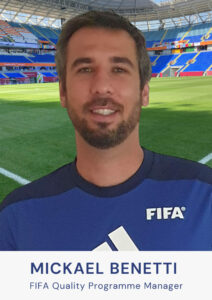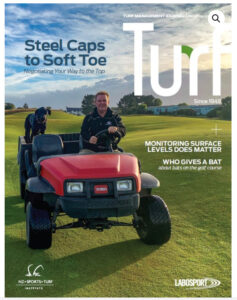 Mickael Benetti is the FIFA Quality Programme Manager for Playing Surfaces – Football Technology & Innovation. He discusses why standardisation has become so important, what influences the standardisation process and how standardisation influences the game of football.
Mickael Benetti is the FIFA Quality Programme Manager for Playing Surfaces – Football Technology & Innovation. He discusses why standardisation has become so important, what influences the standardisation process and how standardisation influences the game of football.
In 1904, the Fédération internationale de football association (French for ‘International Association Football Federation) or FIFA, as it is commonly referred to, was established as the international governing body for football, futsal and beach soccer. FIFA’s role was to oversee international competitions between eight different European countries. Today it has a membership of over 211 national associations. These 211 national associations each also belong to one of the six regional confederations, namely CAF (Africa), AFC (Asia and Australia), UEFA (Europe), CONCACAF (North and Central America and the Caribbean), CONMEBOL (South America), and OFC (Oceania).

A significant part of FIFA’s role as international governing body is to apply and enforce the rules of the game of football in all FIFA competitions globally. In 1996 FIFA determined that there was a need to standardise certain aspects of the game. The first point of focus was the standardisation of football balls. Football players learn to manoeuvre the ball based on its size and weight when they are training. It is therefore understandable that a team who finds themselves playing with a different ball on matchday would be at a disadvantage. By creating international guidelines and standards that specified the dimensions and weight of football balls, FIFA was instantly creating a fairer game. This set the proverbial ball in motion for the standardisation of surfaces. This became the next area of focus in 2001 when FIFA launched its second quality programme that set out to answer the question: “Are artificial surfaces suitable for the game of football?”
DEVELOPING A STANDARD FOR FOOTBALL TURF
The FIFA Quality Programme for Football Turf started by collecting data from around 20 good condition natural turf surfaces in England. It was around this time that tests such as rotational resistance were being introduced by STRI to assess how football players were interacting with natural turf surfaces. Other benchmarking tests such as ball rebound, and ball roll tests were also being used in Europe on natural turf surfaces. The data that was collected from these 20 surfaces served as a control against which FIFA could base their findings as they started the process of assessing the suitability of artificial surfaces for the game of football.

FIFA’s investigation into the suitability of artificial surfaces for football found that these surfaces can be suitable – but only when they are properly and specifically built and maintained to meet specific standards. Emphasis then shifted to quality assurance of the testing process to ensure that anyone who performs surface testing and collects data does this in exactly the same way every time so that the results can be compared equally and without bias.
This gave rise to FIFA creating specific testing procedures and their requirement that anyone doing surface testing be thoroughly trained and accredited by them to sign off that a surface meets the FIFA standard.
REVIEWING FIFA STANDARDS AND QUALITY PROGRAMMES
FIFA has various teams that are constantly working on fresh innovations and reviewing new technologies. There are also working groups from across the football industry who work together with FIFA to identify when specific standards or testing methodologies need to be reviewed. These reviews and potential updates to the way things are done are then implemented as and when necessary. The process of reviewing a standard or a testing method is heavily dependent on data and can take time to complete due to the intricacies of the data that is required. FIFA does not work in isolation but alongside industry partners from the various international football confederations and with expert consultants from the sports turf industry to utilize the wider knowledge base that exists within the industry. There is no one person who writes FIFA’s standards or who makes changes to testing protocols.

Everything is a collaborative effort that is thoroughly tested and reviewed before it is implemented. In addition to the influences mentioned above that can influence a standard review, FIFA is constantly monitoring how football players and football balls interact with the playing surface – in other words, surface performance. This means having safe, durable surfaces that support players to manoeuvrer themselves and the ball without undue risk of injury or a lack of playability.
The durability of a surface is very important. It is not sensible or cost effective to have surfaces that deteriorate quickly, or require costly repairs and maintenance on a regular basis. This ties in with FIFA’s commitment to sustainability which is another factor that is always kept in consideration when methods and standards are reviewed. It is challenging to create international standards when different countries have different regulations. Part of any standard review includes taking this into consideration.
NATURAL TURF STANDARDS
Once FIFA had gone through the process of determining that artificial surfaces could be suitable for football; and the necessary standards, testing methodologies and quality assurance requirements were developed and implemented; international attention shifted back towards natural turf surfaces.
Facilities with artificial surfaces found themselves having to adhere to stringent protocols, regulations, and FIFA accredited testing – but natural turf surfaces didn’t have a similar yardstick. Natural turf pitches varied tremendously in quality and playability around the world.

In 2020, FIFA commissioned Labosport and Sports Labs to join them in a working group that was established to develop a standard for natural football surfaces. Understandably, trying to standardise natural turf surfaces on an international front presents countless challenges. Weather and climate, turf varieties and maintenance practices vary dramatically between continents and countries. By tapping into the existing knowledge of industry experts and including them in their working group, FIFA was able to prepare the Quality Programme for Natural Playing Surfaces. This guide was developed to assist natural turf football pitch managers with clarity around decision-making and to ensure that such pitches are constructed and maintained to a standard that optimises player performance. The guide includes the main stages in the development of football pitches and the maintenance resources required to sustain a good quality playing surface in the different types of climatic zones around the world.
Assessing a natural turf football pitch needs to make allowance for factors that aren’t relevant on artificial surfaces. While certain factors are tested on both, the way in which a surface will pass or fail the relevant FIFA standard will differ and the quality assurance programme for natural turf pitches looks quite different to that which is used for artificial surfaces. The testing of a natural turf pitch can be divided into three basic categories – climatic testing, sports performance testing and agronomic testing. A pitch rating system was developed to allow the quality of natural surfaces to be assessed objectively. The system rates a pitch’s quality up to a maximum score of 100. This programme was successfully used to prepare the pitch for the FIFA World Cup in Qatar last year.
Over the past twenty seven years, since FIFA first decided to standardise football balls in 1996, the international football industry has benefitted tremendously from the research and progress that FIFA has spearheaded as it strives to provide football players around the globe a level playing field in every possible way.
For more information, please visit the FIFA resource hub.
——————————————————————
 This article was originally published in our Turf Management Journal in June. If you’d like to read more articles like this one, consider subscribing here.
This article was originally published in our Turf Management Journal in June. If you’d like to read more articles like this one, consider subscribing here.
Discover the ultimate companion for turf enthusiasts. As a frontrunner among global turf management publications, TMJ stands out as a beacon of knowledge and innovation. Delivered every quarter (March, June, September, and December), TMJ extends its reach not only across the lush landscapes of New Zealand but also to passionate readers worldwide.
Elevate your understanding of turf management with TMJ’s rich educational content, comprising a blend of technical insights, cutting-edge research, topical discussions, and invaluable training articles. Each issue is meticulously crafted to provide you with the latest advancements in turf management technology.








